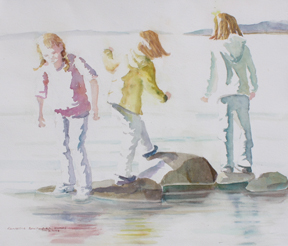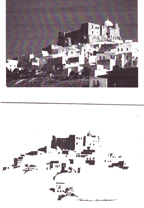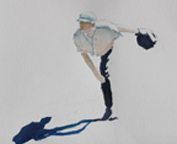
Some background:
 Sunlight explains the world to us. Think of sunlight as passing through a prism and breaking into a rainbow of colors. These are the colors you use to fill your paintings with sunlight (in all values, and combinations).
Sunlight explains the world to us. Think of sunlight as passing through a prism and breaking into a rainbow of colors. These are the colors you use to fill your paintings with sunlight (in all values, and combinations).
The Impressionists starting painting shadows with violets and blues after the study of optics pointed out the prismatic effect of light. At first, their vision seemed wild – people had become used to shading color with black and making color lighter with white pigment. Artists had been overlaying their training in charcoal or ink onto color. How dirty some of those paintings appear after the Impressionists! The Impressionists helped us to see the color in shadows. It is there – you have to look hard, outdoors, in real light .
 When you are working from photos, the camera often blackens the shadows as it meters off the light. Our eyes can see the light and then they reset their meters when we look into the shadows. Color is there!
When you are working from photos, the camera often blackens the shadows as it meters off the light. Our eyes can see the light and then they reset their meters when we look into the shadows. Color is there!
You need to re-introduce the color in the shadows . Using only red-yellow-blue-green-violet-orange you can paint the colors of sunlight and shadow with a richness that our eye recognizes as true.
Here are some exdercises that help you to understand how color acts in sunlight.




all drawings here were done on location
Exercise I: Light bleaches out color
Choose a brightly lit shot of anything – buildings, people and only draw what is not in sunshine. See if you can make the shapes read only drawing the shade sides. the lighthouse at the bottom of this page will work.
 I call this shadow-shape drawing.
I call this shadow-shape drawing.
Try another using a color photo of a subject like the girl on the right. Forget the background, Reduce the figure it to solid shadow, solid light shapes….
Moral: if you want your paintings to feel more sun struck – leave the shapes the sun is striking white paper. As soon as you shade or color them, the sun goes under a cloud.
You can push this — when some color is still showing as was happening in the 3 girls (all one) top, leaving the sun struck area white makes it seem sunnier.
After doing a shadow shape drawing of this girl, try painting her. Perhaps read the following first.
Exercise II: The stronger the sunlight; the more the “true” color is driven down into the shadow.
This is true of flowers, clothes – you name it!
 Notice where it is on the girl’s shirt that we see the true color of the shirt, or the skin on her legs, on her shoes. Look through your photos and find good examples.
Notice where it is on the girl’s shirt that we see the true color of the shirt, or the skin on her legs, on her shoes. Look through your photos and find good examples.
Moral: save the purest, most intense hue for the middle of the shade side.
Exercise III: The shadow is darkest and coolest on the edge against the sunlight. It becomes lighter and warmer as it moves away from this edge.
 Try painting an object and cast shadow this way. Draw up a rock, or an orange or some other simple shape and represent the plane toward the light as white paper,
Try painting an object and cast shadow this way. Draw up a rock, or an orange or some other simple shape and represent the plane toward the light as white paper,
If an orange
- wet the shape and leave the sunstruck area white
- bush into the wet shape the orange color, using more as it turns away from the light, possibly adding red
- at the “waistline” where it turns away from the light, add some blue
- ugh
- immediately rechange this with orange – voila!
This is also how you would paint a face or an arm.
Notice, in the little girl in the photo above, the edge of the shadows are ALL darker and cooler than the little girl. Here are two quick sketches done as demonstrations and a sudio painting of my grandson’s 2nd birthday.



Don’t forget the light bounce. Check the underbellies of the horses in the painting of The Light Brigade. The hues tell us that the sun is hitting yellow grass with enough strength to reflect into their bellies. The fruit in the bowl above have light bounces in their shadow side. The shirt of the girl on the left reflects the color in her arm. The litle boy on the right has a bounce of light on the under side of his chin. Also notice how the yellow against the white is cooler and darker.
Moral: If you want you paintings to become more sunstruck, watch for the darker edge to the shadow (and add a little light bounce in the shade side too).
 Exercise IV. Cast Shadows bring out the sunlight.
Exercise IV. Cast Shadows bring out the sunlight.
When you draw up your painting, draw in the cast shadows. They are part of the design. They have shapes. When in doubt, paint them in violets or lavenders – but keep the colors moving and changing as discussed above.
The reason the fisherman, above, appears in stronger sunlight than the little girls at the top of this discussion is because of the VALUE of the shadow shapes. They are full of rich colors that are not adequately reproduced here.


 Get out and paint the sunshine! I hope you are inspired to start looking. On sunny days start SEEING how color disappears when the sun is brightest, how the color of the object can be seen in the shade side, how the edge of the shadow toward the light is cooler and darker than the rest of the shadow — and how cast shadows (never black or gray) bring out the sunshine.
Get out and paint the sunshine! I hope you are inspired to start looking. On sunny days start SEEING how color disappears when the sun is brightest, how the color of the object can be seen in the shade side, how the edge of the shadow toward the light is cooler and darker than the rest of the shadow — and how cast shadows (never black or gray) bring out the sunshine.
© 2012 Caroline Buchanan
